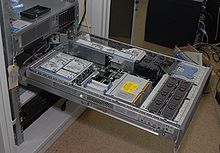
Compaq Computer Corporation was an American information technology company founded in 1982 that developed, sold, and supported computers and related products and services. Compaq produced some of the first IBM PC compatible computers, being the second company after Columbia Data Products to legally reverse engineer the BIOS of the IBM Personal Computer. It rose to become the largest supplier of PC systems during the 1990s before being overtaken by Dell in 2001. Struggling to keep up in the price wars against Dell, as well as with a risky acquisition of DEC, Compaq was acquired for US$25 billion by HP in 2002. The Compaq brand remained in use by HP for lower-end systems until 2013 when it was discontinued. Since 2013, the brand is currently licensed to third parties for use on electronics in Brazil and India.

Itanium is a discontinued family of 64-bit Intel microprocessors that implement the Intel Itanium architecture. The Itanium architecture originated at Hewlett-Packard (HP), and was later jointly developed by HP and Intel. Launched in June 2001, Intel initially marketed the processors for enterprise servers and high-performance computing systems. In the concept phase, engineers said "we could run circles around PowerPC...we could kill the x86." Early predictions were that IA-64 would expand to the lower-end servers, supplanting Xeon, and eventually penetrate into the personal computers, eventually to supplant reduced instruction set computing (RISC) and complex instruction set computing (CISC) architectures for all general-purpose applications.

HP-UX is Hewlett Packard Enterprise's proprietary implementation of the Unix operating system, based on Unix System V and first released in 1984. Current versions support HPE Integrity Servers, based on Intel's Itanium architecture.
Cray Inc., a subsidiary of Hewlett Packard Enterprise, is an American supercomputer manufacturer headquartered in Seattle, Washington. It also manufactures systems for data storage and analytics. Several Cray supercomputer systems are listed in the TOP500, which ranks the most powerful supercomputers in the world.
NonStop is a series of server computers introduced to market in 1976 by Tandem Computers Inc., beginning with the NonStop product line. It was followed by the Tandem Integrity NonStop line of lock-step fault-tolerant computers, now defunct. The original NonStop product line is currently offered by Hewlett Packard Enterprise since Hewlett-Packard Company's split in 2015. Because NonStop systems are based on an integrated hardware/software stack, Tandem and later HPE also developed the NonStop OS operating system for them.
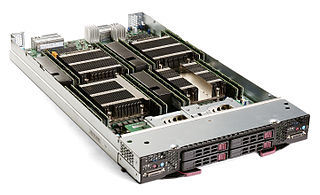
A blade server is a stripped-down server computer with a modular design optimized to minimize the use of physical space and energy. Blade servers have many components removed to save space, minimize power consumption and other considerations, while still having all the functional components to be considered a computer. Unlike a rack-mount server, a blade server fits inside a blade enclosure, which can hold multiple blade servers, providing services such as power, cooling, networking, various interconnects and management. Together, blades and the blade enclosure form a blade system, which may itself be rack-mounted. Different blade providers have differing principles regarding what to include in the blade itself, and in the blade system as a whole.
HPE Integrity Servers is a series of server computers produced by Hewlett Packard Enterprise since 2003, based on the Itanium processor. The Integrity brand name was inherited by HP from Tandem Computers via Compaq.

The HPE Storage (formerly HP StorageWorks) is a portfolio of HPE storage products, includes online storage, nearline storage, storage networking, archiving, de-duplication, and storage software. HP and their predecessor, the Compaq Corporation, has developed some of industry-first storage technologies to simplify network storage. HP is a proponent of converged storage, a storage architecture that combines storage and compute into a single entity.
HP Pavilion is a line of consumer-oriented laptop and desktop computers produced by HP Inc. Introduced in 1995, HP has used the name for both desktops and laptops in its home and home office product range. The Pavilion mainly competes against computers such as Acer's Aspire, Dell's Inspiron and XPS, Lenovo's IdeaPad, Samsung's Sens, and Toshiba's Satellite.
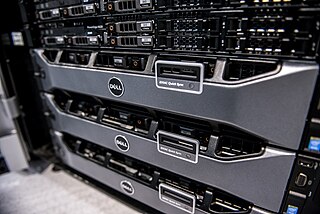
The PowerEdge (PE) line is Dell's server computer product line. PowerEdge machines come configured as tower, rack-mounted, or blade servers. Dell uses a consistent chip-set across servers in the same generation regardless of packaging, allowing for a common set of drivers and system-images.
Integrated Lights-Out, or iLO, is a proprietary embedded server management technology by Hewlett-Packard Enterprise which provides out-of-band management facilities. The physical connection is an Ethernet port that can be found on most ProLiant servers and microservers of the 300 and above series.

AlphaServer is a series of server computers, produced from 1994 onwards by Digital Equipment Corporation, and later by Compaq and HP. AlphaServers were based on the DEC Alpha 64-bit microprocessor. Supported operating systems for AlphaServers are Tru64 UNIX, OpenVMS, MEDITECH MAGIC and Windows NT, while enthusiasts have provided alternative operating systems such as Linux, NetBSD, OpenBSD and FreeBSD.
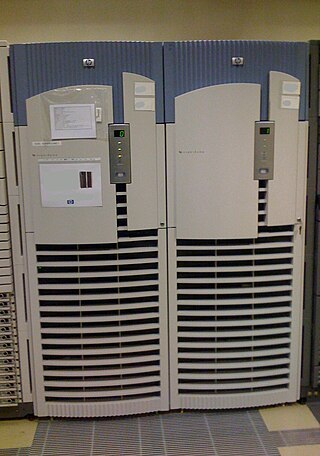
The HP Superdome is a high-end server computer designed and manufactured by Hewlett Packard Enterprise. The product's most recent version, "Superdome 2," was released in 2010 supporting 2 to 32 sockets and 4 TB of memory. The Superdome used PA-RISC processors when it debuted in 2000. Since 2002, a second version of the machine based on Itanium 2 processors has been marketed as the HP Integrity Superdome.
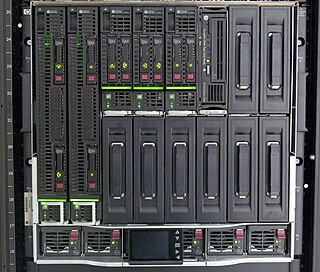
BladeSystem is a line of blade server machines from Hewlett Packard Enterprise that was introduced in June 2006.
HP ConvergedSystem is a portfolio of system-based products from Hewlett-Packard (HP) that integrates preconfigured IT components into systems for virtualization, cloud computing, big data, collaboration, converged management, and client virtualization. Composed of servers, storage, networking, and integrated software and services, the systems are designed to address the cost and complexity of data center operations and maintenance by pulling the IT components together into a single resource pool so they are easier to manage and faster to deploy. Where previously it would take three to six months from the time of order to get a system up and running, it now reportedly takes as few as 20 days with the HP ConvergedSystem.

The Hewlett Packard Enterprise Company (HPE) is an American multinational information technology company based in Spring, Texas.

Ampere Computing LLC is an American fabless semiconductor company based in Santa Clara, California that develops processors for servers operating in large scale environments. Ampere also has offices in: Portland, Oregon; Taipei, Taiwan; Raleigh, North Carolina; Bangalore, India; Warsaw, Poland; and Ho Chi Minh City, Vietnam.
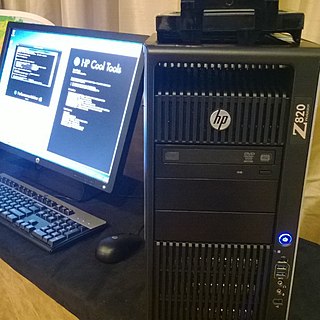
HP Z is a series of professional workstation computers developed by Hewlett-Packard. The first-generation desktop products were announced in March 2009, replacing the HP 9000 xw series. The product line expanded to mobile with the announcement of ZBook in September 2013, replacing HP's EliteBook W-series mobile workstations. The Z workstations mainly compete against Dell's Precision workstations, Lenovo's ThinkStation and ThinkPad P series workstations, as well as Apple's Mac Pro and MacBook Pro.

NetServer was a line of x86-based server and workstation computers sold by Hewlett-Packard (HP) from 1993 to 2002. It was Hewlett-Packard's first entry in the commodity local area networking (LAN) market.


